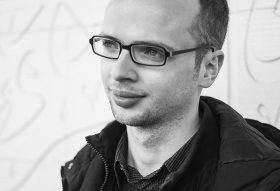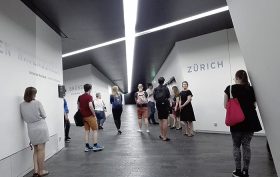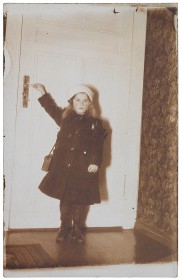
Ármin Langer; Foto: Kat Kaufmann
As part of the series “New German Stories,” we will present the book Ein Jude in Neukölln. Mein Weg zum Miteinander der Religionen (A Jew in Neukölln. My path to the coexistence of religions) by Ármin Langer on 19 October 2016. The author, who will be our guest on this evening, will talk about his life as a Jewish activist and his experiences as coordinator of the Berlin Salaam-Shalom initiative that sets an example of peaceful Jewish-Muslim coexistence.
We asked Ármin Langer three questions:
Alina Gromova: Ármin, you decided at the age of 21 years to become a rabbi even though you are from a secular family. What led you to this decision back then?
Ármin Langer: Already as a child I was open to religion, but this feeling found no frame until I was 20. → continue reading
An Architectural Instawalk through the Jewish Museum Berlin

Instagrammers in the Libeskind Building; Jewish Museum Berlin, photo: Judith Westphal
Where might one best spend the hottest day of the year? If not on the water or in the woods, there are only a few reasonable options. For example, an air conditioned museum with lots of underground passages! Fitting then that as part of Architecture Day on Friday, June 24th 2016, we led a very special kind of museum tour: Equipped with smartphones and professional cameras, we took a group of Berliner Instagrammers through the labyrinth that is the Libeskind Building, with Tommaso as guide. Even we as staff were able to learn a thing or two. → continue reading
A Photo Collection Found Hiding in Berlin-Friedrichshain

A girl standing in front of a door, presumably Berlin, about 1918–1922; Jewish Museum Berlin
Every time I open a new folder of photos, I can’t know what’s waiting for me – what faces I’ll find or fates will be revealed. Images are often part of a larger collection, consisting of documents, everyday articles and artwork, for which we already know the biographies of those pictured or can further research. Such was the case, for example, of the cabaret artist, Olga Irén Fröhlich, whom I’ve written about before on this blog. This time, however, the people in the photographs will remain unknown to me; I won’t be able to attach names or histories to them. Perhaps you can!
It’s not out of the ordinary to work with collections that have been in the Museum’s possession for decades. → continue reading


